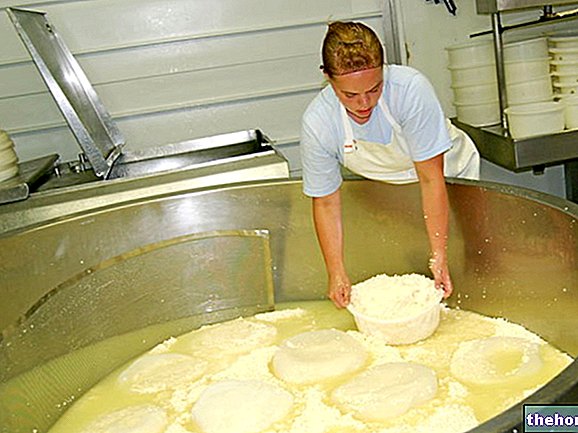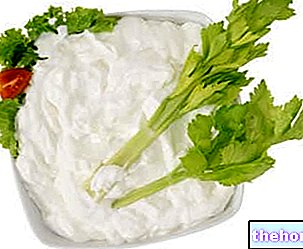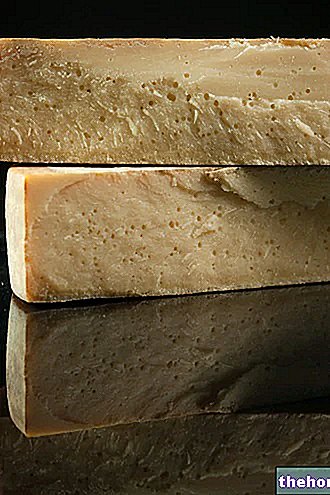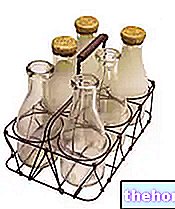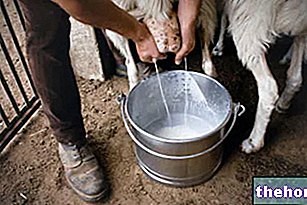Milk: general aspects
Milk is essentially a food.

Milk appears as a white and opaque liquid, sweet and with an almost neutral pH; chemically, milk is an "EMULSION of lipid globules dispersed in a fluid similar (in composition) to blood plasma; this fluid is in turn composed of dissolved proteins and whey (salts, lactose and water).
From a nutritional point of view, milk provides ESPECIALLY four types of nutrients:
- Lipids (especially triglycerides and cholesterol)
- Protides (caseins, albumin and globulins)
- Glucides (essentially lactose, a disaccharide composed of glucose + galactose)
- Salts (calcium, phosphorus, etc.)
However, the other quantitatively lower components are also noteworthy, such as vitamins, lecithins, enzymes, nucleotides, prebiotics, antibodies etc.
Milks are not all the same; in addition to the more or less significant differences present in the different mammal species, the LACTATION CYCLE also determines significant variations on the chemical composition of the mammary secretion. At the time of birth, for example, milk is defined COLOSTRUM and differs from that produced later for the importance of the protein and saline components; subsequently, the breast changes the composition of the fluid, depleting it of nutrients as the weeks.
Lactose
Lactose is the characteristic carbohydrate of milk; it is present to varying degrees among the secretions of the different species but, compared to the other nutrients, its content is limited in heterogeneity. Lactose is particularly present in human milk, in which it reaches more than half the dry weight (65 g / l), but its content is also very abundant in cow and goat secretion; in humans, lactose is produced starting from glucose, while in ruminants the starting substrate is constituted by the volatile acids present in the rumen. Furthermore, since lactose is very abundant and characterized by a considerable osmotic power, the impairment of its synthesis represents a limiting factor in overall breast milk production.
Lactose, in addition to having an energetic function, represents the primary source of galactose, which in turn is an "important structural component of nervous tissues.
Lactose is also a typical substrate of many microorganisms that break it down producing lactic acid or other aliphatic acids, while in the "animal organism" the hydrolysis of lactose and the desmolysis of galactose depend on the presence / enzymatic availability of:
- β-1,4 galactosylase, also called intestinal lactase
- Galactose-1-phosphate uridyltransferase, also called hepatic galactase
"Ordinary" lactose also has several analogous isomers or disaccharides; these can replace other glucose monosaccharides or can derive from lactose following the application of different chemical or physical processes; among these we remember:
- Epilactose: galactose + mannose → Typical of strongly heated milk
- Lactulose: galactose + fructose → Resulting from the alkaline treatment
- Allolactose: galactose + glucose → Has a β 1,6 bond and is typical of transglycosylation by β-galactosidase
- Lactitol: galactose + sorbitol → Lactose reduction product
NB. For osmotic regulation, the concentration of lactose is INVERSEALLY proportional to that of the salts
What is delactosed milk?
Delactosed milk, also called HD (High Digestible), is a food created by man and conceived in order to allow lactase deficient subjects (or populations!) To consume cow's milk without incurring the typical (and unpleasant) symptoms gastro-intestinal lactose intolerance.
Lactase insufficiency, often but not always, derives from some genetic factors; sometimes it is a transient deficiency, while other times it concerns a permanent but NOT hereditary deficiency, attributable to the definitive elimination of milk from the diet; in this case, after long periods of abstinence from milk, the concentration of intestinal lactase progressively decreases until it becomes INSUFFICIENT.
Delactosed milk is nothing more than cow's milk subjected to ENZYMATIC hydrolysis of lactose; this process allows to reduce lactose concentrations up to 70% of the initial concentration. The production of delactosed milk is becoming increasingly important thanks to the high number of consents among consumers.
The chemical process of lactic hydrolysis occurs through the use of specific enzymes; among these the most used are:
- Yeast lactase: Kluyveromyces fragilis or Saccharomyces lactis
- Fungal lactase: Aspergillus niger, Rhizopus oryzae etc.
Although the final result is the same, the technological-food process to be applied, if one or the other enzyme is used, must take into account at least two factors: pH and temperature. The lactases of yeasts act in fact at neutral pH and at medium temperature, while the fungal ones act in an acid medium and at high temperatures.
NB. All heavy metals inhibit this reaction
Why not use thermal hydrolysis?
Obviously, wherever an enzymatic reaction is present it is possible to reproduce it in the absence of the catalyst by means of a chemical or physical process; therefore, the production of delactosed milk is no exception. In fact, lactose can also be degraded simply by using a heat treatment between 110 and 130 ° C (remember that at 150 ° the lactose yellow and at 175 ° C caramelizes).
It goes without saying that the finished result is absolutely not the same! While the production of delactosed milk with hydrolytic enzymes allows the taste, color and aroma of ordinary milk to be kept almost unchanged (resulting only a little sweeter), if if heat degradation was used, qualitative alterations would be inevitable, such as:
- Browning / yellowing
- Acquisition of the taste of "cooked"
- Acidification by release of levulic acid and formic acid
- Formation of aldehydes
Curiosity:
To date, the only known mammal species that does NOT produce lactose is the CALIFORNIA SEA LION.
Bibliography:
- Milk chemistry and technology - C. Corradini - New techniques - page 45
- Milk science. 3rd Edition - C. Alais– New techniques
Milk, Dairy Products and Cheeses Asiago Brie Burrata Caciocavallo Rennet Camembert Cheddar Milk Cream Crescenza Emmental Feta Milk Flakes Fontina Herbal Cheeses Lean Cheeses Cheeses rich in calcium Gorgonzola Gouda Grana Padano Gruyere Kéfalair Adapted milk Artificial milk Condensed milk Asphyxiated milk Goat's milk Sheep's milk Rice milk Soy milk Powdered milk and concentrated milk Skimmed and semi-skimmed milk Lactose-free milk Milk Vegetable milk Dairy products Lerdammer Mascarpone Montasio Buffalo mozzarella Mozzarella Whipped cream Cooking cream Fresh cream Parmigiano Reggiano Pecorino Philadelphia Primo Sale Provolone Ricotta Robiola Roquefort Scamorza Sottilette Squacquerone Taleggio Tomino Yogurt OTHER ARTICLES MILK AND DERIVATIVES Categories Alcoholic foods Meat Cereals and derivatives Sweeteners Sweets Offal Fruit Dried fruit Milk and derivatives Legumes Oils and fats Fish and fishery products Cold cuts S pezie Vegetables Health recipes Appetizers Bread, Pizza and Brioche First courses Second courses Vegetables and Salads Sweets and Desserts Ice creams and sorbets Syrups, liqueurs and grappa Basic preparations ---- In the kitchen with leftovers Carnival recipes Christmas recipes Light diet recipes Women's Day, Mum, Dad Recipes Functional Recipes International Recipes Easter Recipes Recipes for Celiacs Recipes for Diabetics Recipes for Holidays Recipes for Valentine's Day Recipes for Vegetarians Protein Recipes Regional Recipes Vegan Recipes

